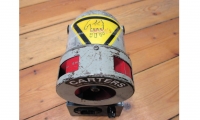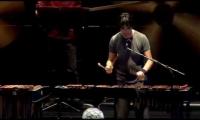October 26th, 2013,
Handelsbeurs, Ghent
PROGRAMMA
Een Medley van mechanische werken voor twee akoestische piano's met Ligeti, Reich, Bartok en Nancarrow
Jean-Paul Van Bendegem : Lezing
George Antheil (1900-1959) : Ballet Mécanique (1924)
CAST
Georges-Elie Octors | dirigent
Jean-Luc Fafchamps, Jean-Luc Plouvier | piano
Miquel Bernat, Tom De Cock, Adam Rosenblatt | xylofoon
Gerrit Nulens | basdrums
Michael Schmid, Alexis Bourdon, Tom Pipeleers, Yukari Uekawa | propellers, elektrische bellen, tam-tam, sirenes
Wilfried Van Dyck | productieleiding
BALLET MECANIQUE
As a companion to the ultra-machine-like approach of George Antheil, the self-proclaimed "Bad Boy of Music" of the 20th century, a conference-cum-bantering session from the Flemish scientist Jean-Paul Van Bendegem, a melting pot of sciences, maths & music.
Ballet Mécanique (1924), the original version of which we propose to re-enact (slightly revamped), was an attempt by the American composer George Antheil, the painter Fernand Léger, and the director Dudley Murphy to offer a multimedia experience before there was even a name for it.
In common with Edgar Varèse – although he was the author of a work that was much more uneven - the American George Antheil incarnated in France the very model of a "futurist" composer, thanks to his outrageous and impassioned attitude. An ephemeral friend of Stravinsky, admired by James Joyce and Jean Cocteau and adored by Ezra Pound, who hyped the composer to high heaven, the brilliant "Bad Boy of Music" (as he dubbed himself in his autobiography), dreamed up a wildly engine-like work, the most mercilessly mechanical score imaginable, outmatching the Noces by Igor Stravinsky, by which he had just been thunderstruck. Where Stravinsky had deployed four pianos, Antheil opted for 16. Sixteen mechanical pianos flanked by helicopter blades, sirens, eight bells, three xylophones and numerous percussion instruments. The form was cast in one piece "like a tree made of steel, while the style was at times cool and glistening and at other times burning like an electric oven". More: "With Ballet Mécanique, I am offering you for the first time music that is as hard and beautiful as a diamond ", he dared to write. But the best laid plans of mice and men... : the 16 unsynchronisable mechanical pianos were reduced to a single one, while four authentic pianists were recruited. On the opening night, the wigs of the audience members sitting in the front row were blown off by the helicopter blades, the sirens could not be stopped, it was omnishambolic. In the year 1952, the more restrained and neo-classical composer returned to the music and rearranged it to produce a lighter rhythm. What we are now offering is more or less the original idealistic and madly startling version of 1924, in keeping with the first manuscript. The sole difference is that the 16 mechanical pianos have given way to a horde of 16 synthesisers. Stravinsky's dissonance stretched to the limit, the unflagging repetition, the chemistry at work in the machine-like heavy-handedness and the lightening speed – all of these ingredients succeed in making the Ballet Mécanique a wholly unique work in the history of the 20th century
As for Fernand Léger's specially commissioned film it will never be produced at the same time as Antheil musical work. From what ever angle it is tackled, the final cut fails to match the score. We will be offering a seven-minute extract, very slightly altered to obtain two or three points of intersection with the musical form. Léger was an enthusiastic participant in the adventure, during a period plagued by doubt, where the power of cinema rendered him somewhat inhibited and despairing when it came to painting: he had seen the Roue by Abel Gance and the films by Chaplin. It was then that he was struck by the idea of a "simultaneous" lyrical form (a typically futurist expression) of the moving image, dominated by extracts and close-ups.
He wrote: "No script. A series of rhythmical images, nothing else [...]. We persist until the observer's eye and spirit cannot stand any more, exhausting the entertainment value until it becomes positively unbearable."
Tag : Percussion
BALLET MECANIQUE
Van George Antheil, de zelfverklaarde Bad Boy of Music uit het begin van de twintigste eeuw brengt Ictus het futuristische 'Ballet Mécanique'. Voor tegengewicht zorgt Professor Jean-Paul Van Bendegem met een lezing die laveert tussen wetenschap, filosofie en muziek.
Als een klap op de vuurpijl wordt een eigentijdse versie opgevoerd van Ballet Mécanique (1924) het multimediale experiment van de Amerikaanse componist George Antheil en de schilders/cinematografen Fernand Léger en Dudley Murphy. De beeldtaal ademt de geest van het dadaïsme en futurisme van het begin van de twintigste eeuw: simultane poëzie, aaneenschakeling van beelden zonder narratieve structuur.
Frenand Léger: “Geen scenario. Een ritmische opeenvolging van beelden, dat is alles […]. We gaan door tot het oog en de geest van de toeschouwer het niet meer aankunnen”. Eenzelfde drang naar verzadiging typeert de instrumentatie van de muzikale compositie. Zestien automatische piano’s, vliegtuigpropellers, sirenes, acht bellen, xylofonen en een uitgebreide percussie-sectie. Antheil karakteriseerde zijn magnum opus als “soms koud en glimmend, soms brandend als elektrisch vuur”. Of ook: “met Ballet Mécanique presenteer ik u voor de eerste keer een muziek met de hardheid en de schoonheid van een diamant”. Maar niets liep zoals gehoopt: de vooropgestelde zestien mechanische piano’s bleken niet synchroniseerbaar en werden teruggebracht tot één exemplaar, tijdens de première werden de pruiken van de toeschouwers op de eerste rij afgeblazen door het geweld van de propellers, de sirenes stopten niet op bevel: totale chaos.
Bovendien zorgden onderlinge verschillen in lengte ervoor dat de film en de muziek decennialang een eigen leven leidden. Pas eind jaren negentig werd een poging gedaan om de oorspronkelijke intentie, een gesychroniseerde uitvoering van beeld en klank, mogelijk te maken. In de Handelsbeurs wordt een alternatieve versie gepresenteerd waarin zowel de kracht van de autonome muziekuitvoering als de combinatie van film en muziek een kans krijgen. De zestien automatische piano’s worden vervangen door virtuele synthesizers, maar voor het overige zorgt Ictus voor een uitvoering die dicht in de buurt komt van het originele plan van Antheil. Uit de film van Léger worden zeven minuten geselecteerd die op een minimale wijze worden gemonteerd om tot een symbiose van klank en muziek te komen. De repetitieve, non-narratieve beelden en onverwachte cuts, ze lijken op één of andere manier steeds wonderwel ‘in sync’ te zijn met het stuwende, theatrale ‘ballet’ van mechanische instrumenten, propellers, sirenes en slagwerkinstrumenten.
BALLET MECANIQUE
Pour accompagner l’hyper-machinisme de George Antheil, voici une conférence-badinage du scientifique flamand Jean-Paul Van Bendegem où se mêlent sciences, maths et musique.
Ballet Mécanique (1924), dont nous proposons une reconstitution de la version originale (légèrement revue), fut une tentative d'expérience multimédia avant la lettre du compositeur américain George Antheil, du peintre Fernand Léger, du réalisateur Dudley Murphy.
Tout comme Edgar Varèse - quoiqu'il fût l'auteur d'une oeuvre beaucoup plus inégale - l'Américain George Antheil a incarné en France le modèle du compositeur "futuriste", scandaleux et exalté. Ami d'un jour de Stravinsky, admiré de James Joyce et Jean Cocteau, adoré d'Ezra Pound qui lui assura une tapageuse promotion, le brillant "Bad Boy of Music" (comme il se désigna lui-même dans son autobiographie), imagina la partition la plus follement motorique, la plus impitoyablement mécanique qui puisse se rêver, en surenchère aux Noces d'Igor Stravinsky, qui venaient de le foudroyer. Stravinsky avait utilisé quatre pianos ? Antheil en mettrait seize. Seize pianos mécaniques, flanqués d'hélices d'avions, de sirènes, de huit sonnettes, de trois xylophones et de nombreuses percussions. La forme ? Coulée d'une pièce "comme un arbre d'acier". Le style ? "Tantôt froid et luisant, tantôt brûlant comme une fournaise électrique". Et encore : "Avec Ballet Mécanique, je vous offre pour la première fois une musique aussi dure et belle qu’un diamant", se risque-t-il à écrire.
Mais rien ne marcha comme prévu : les seize pianos mécaniques, insynchronisables, furent ramenés à un seul, tandis qu'on recrutait quatre vrais pianistes; et le jour de la première, les perruques des spectateurs du premiers rang s'envolèrent sous l'effet des hélices, les sirènes ne s'arrêtaient plus, le désordre fut immense. En 1952, assagi et néo-classique, Antheil reviendra sur cette partition et la ré-arrangera dans un tempo allégé, plus rapide et plus souple . Aujourd'hui, c'est à peu de choses près la version originale, trépignante, utopique et effrayante de 1924 que nous vous proposons, conforme au premier manuscrit. Seul changement : les seize pianos mécaniques sont remplacés par une horde de seize synthétiseurs. La dissonance stravinskienne poussée à bout, la répétition inlassable, l'alchimie de lourdeur machinique et de vitesse fulgurante font de ce Ballet une oeuvre totalement singulière dans l'histoire du XXe siècle.
Quant au film de Fernand Léger tourné pour l'occasion, il ne sera jamais donné en même temps que l'oeuvre musicale d'Antheil. Par quel bout qu'on le prenne, le montage ne correspond pas à la partition. Nous en donnerons un extrait de sept minutes, très légèrement remonté pour obtenir deux ou trois points de jonction avec la forme musicale. Léger s'était consacré avec passion à l'expérience, dans une période de doute où la puissance du cinéma l'avait quelque peu inhibé et désespéré de la peinture : il avait vu La Roue d'Abel Gance et les films de Chaplin. C'est alors qu'il eut l'idée d'une poésie "simultanée" (mot typiquement futuriste) d'images en mouvement, où dominent le fragment et le gros plan. Il écrivit ceci : Aucun scénario. Des successions d'images rythmées, c'est tout [...]. Nous insistons jusqu'à ce que l'oeil et l'esprit du spectateur ne l'acceptent plus. Nous épuisons sa valeur-spectacle jusqu'au moment où il devient insupportable.




